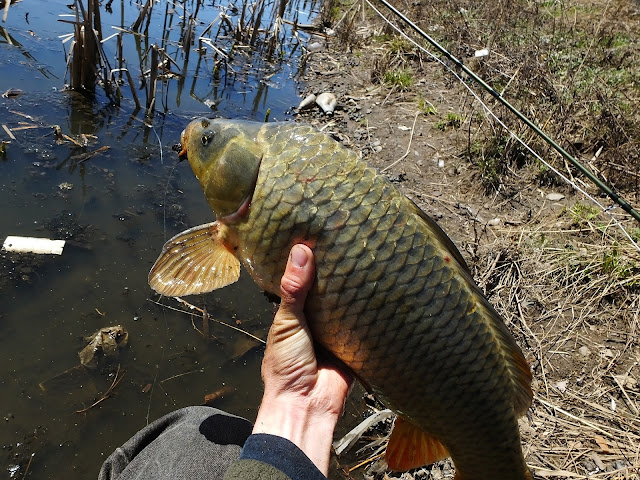I was on my home river again on Monday. There are two times of year when magic happens there. Magic can happen any time of year, but in spring and early winter it is infinitely more likely. The springtime magic most frequently comes in the form of a prolific Paraleps hatch that gets every trout in the stream looking up, even the rare 15-18 inch giants. So I've been going there looking to catch the magic hatch. I almost materialized on Monday. For the first time this year duns were coming off
and the fish took notice, although that only lasted for about half an hour.
Leading up to the first rise I saw I fished nymphs. Specifically, Walt's Worm with an orange hotspot. The water was a lot warmer than the previous outing from the start so it did not take long at all to get consistent action. A bunch of wild browns, a couple rainbows, a smattering of salmon... it was a good bite.
Then, as I climbed over a new log jam that had created a big slow pool where a set of runs had been, I saw what I had been waiting for. A large riser, gently taking duns. Alright, time to back off and watch.
I sat. I watched. I made edits to my leader, greased it up, and tied on my Paraleptophlebia Dun. Then I sat some more. And watched some more.
Then, when I felt all was right, I made a cast. I gave it six drifts. The fish rose twice between them, so I knew it had not spooked. I reeled up and sat and watched again. In that time I changed flies twice. It seems silly to tie a fly on and take it off and switch before making another cast, but sometimes seeing the fly tied on is what it takes for me to fully make up my mind. My end choice was a size 12 Quigley Cripple. Why fish a size 12 fly over a size 18-16 hatch? These small stream fish aren't as picky as trout on large pressured rivers, sometimes it takes a bigger fly to get noticed. Three drifts and the fly was taken. I waited for the fish to turn and lifted the rod. It was a heavy fish, and up until I got a really clear look at it I thought for sure it was going to be the fish of the year for this stream. Alas, it was just a large stocker. I thanked it for playing along and giving me an exciting fight and continued upstream, picking a couple really good fish on nymphs before getting to the next pool.


Once there, saw what I thought was two different risers. I switched to the Paralep Dun and caught the first, a small brown, on the first presentation. I dried the fly and made the cast to the larger fish. Again, one cast, one rise, one wild trout to hand. A gorgeous one. I was giddy at this point. This is what this hatch is all about to me.
To my surprise, when I looked up there was still on riser in the pool, in the exact place of the one I had just caught. I retied with a Quigly. One cast, one rise, one fish. This time it was a holdover rainbow, the same on I had just caught days before in the same spot, and back in December in the same pool too. This time I opted not to take a photo as at this point I think I have bothered it enough, so here's a different photo from the last time I caught him.
Unfortunately the hatch was tapering off at that point and I wouldn't catch anymore fish on dries. The nymph bite remained steady, however.
The fish I ended the outing on was the biggest brook trout I'd caught in my home river in 4 years, a stunning foot long fat female. I wish I could show you a photo of her, I really do, but sometimes the fish does what the fish wants and I'm left sitting there holding my camera wishing I hadn't taken the fly out before taking a photo. Regardless, a great ending to a fair day. No magic, but that may well just be waiting till next time.

























































